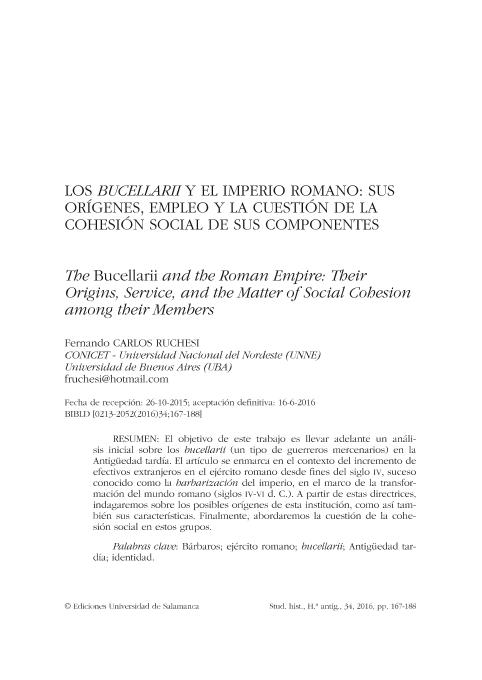Artículo
El objetivo de este trabajo es llevar adelante un análisis inicial sobre los bucellarii (un tipo de guerreros mercenarios) en la Antigüedad tardía. El artículo se enmarca en el contexto del incremento de efectivos extranjeros en el ejército romano desde fines del siglo IV, suceso conocido como la barbarización del imperio, en el marco de la transformación del mundo romano (siglos IV-VI d. C.). A partir de estas directrices, indagaremos sobre los posibles orígenes de esta institución, como así también sus características. Finalmente, abordaremos la cuestión de la cohesión social en estos grupos. The aim of this article is to introduce a preliminary analysis about the bucellarii (a type of mercenary soldiers) during 4th and 5th centuries A.D. Such analysis is presented in the context of the increase of foreign soldiers in the Roman army since the end of the fourth century, an event known as the barbarization of the empire, within the broad framework of the transformation of the Roman world (4th to 6th centuries A.D.). I will enquire about the possible origins of this institution as well as its characteristics. Finally, I will also address the topic of the social cohesion of these groups.
Los bucellarii y el Imperio Romano: sus orígenes, empleo y la cuestión de la cohesión social de sus componentes
Título:
The bucellarii and the Roman Empire: their origins, service, and the matter of social cohesion among their members
Fecha de publicación:
10/2016
Editorial:
Universidad de Salamanca
Revista:
Studia Historica: Historia Antigua
ISSN:
0213-2052
e-ISSN:
2530-4100
Idioma:
Español
Tipo de recurso:
Artículo publicado
Clasificación temática:
Resumen
Palabras clave:
Bárbaros
,
Ejército Romano
,
Bucellarii
,
Antigüedad Tardía
,
Identidad
Archivos asociados
Licencia
Identificadores
Colecciones
Articulos(IIGHI)
Articulos de INST.DE INVEST.GEOHISTORICAS (I)
Articulos de INST.DE INVEST.GEOHISTORICAS (I)
Citación
Ruchesi, Fernando Carlos; Los bucellarii y el Imperio Romano: sus orígenes, empleo y la cuestión de la cohesión social de sus componentes; Universidad de Salamanca; Studia Historica: Historia Antigua; 34; 10-2016; 167-188
Compartir




